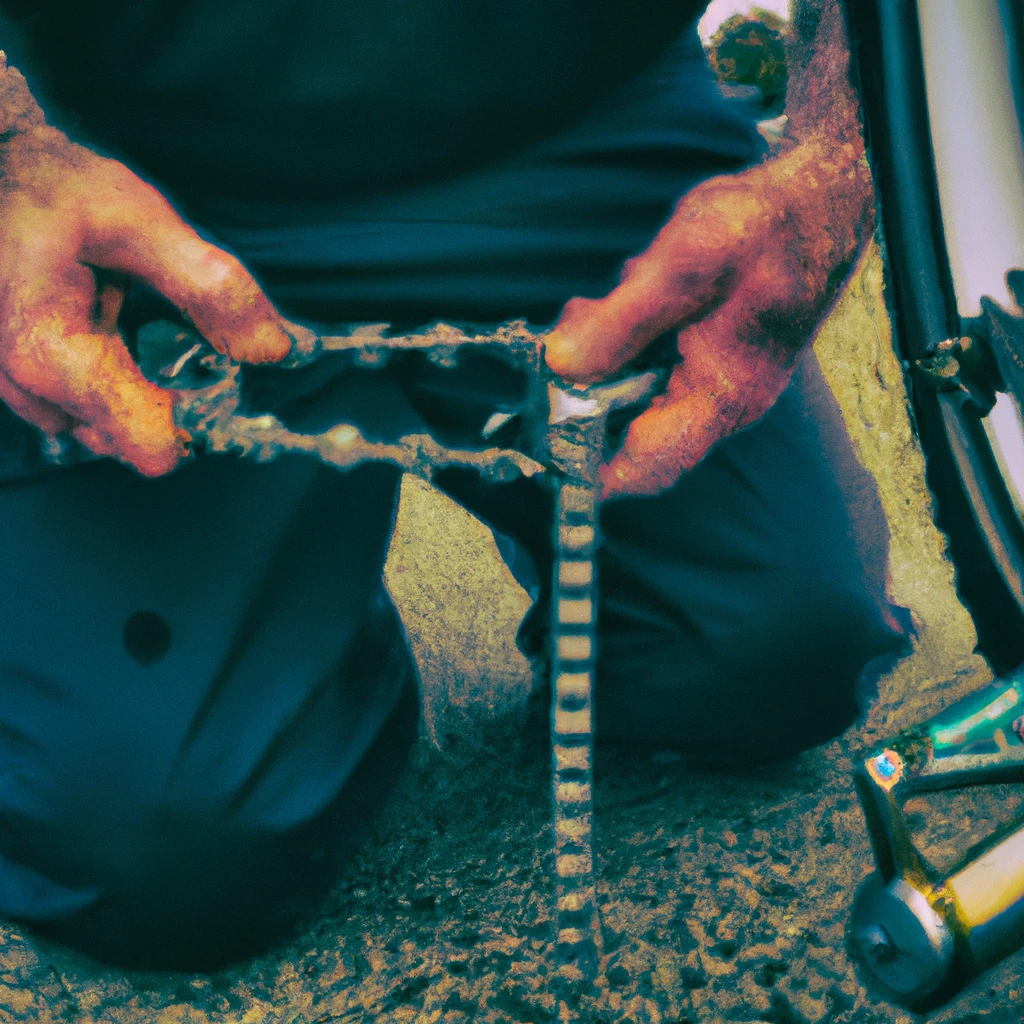Introduction: My Experience with Road Bike Lubrication
Having spent countless hours on the saddle, pedaling away on both urban roads and winding countryside tracks, I’ve accrued a wealth of personal experience with road bike lubrication. I’ve meticulously tested, pondered, and debated between various lubricants – a quest of sorts that has both enlightened me and left my garage cluttered with various half-used bottles of lube. More specifically, the ongoing debate between wet and dry lube for road bike chains continues to be a topic of great relevance and discussion in my biking circles.
My first encounter with dry lube had been one spring morning before setting off on a much-anticipated countryside ride. A friend, a fellow cyclist, handed me a bottle of the stuff, promising that this magic potion would keep my chain cleaner compared to the ‘sticky tar’ I was accustomed to – wet lube. Excited by the prospect, I gave it a try. As weeks and miles rolled by, I noticed the perks, and indeed, my chain was far cleaner than it used to be. However, the frequency I need to reapply was concerning.
Subsequently, I returned to wet lube, a tried and trusted companion of mine, appreciating its ability to sustain long intervals between applications. Riding through rain-soaked roads, my chain remained notably quiet, a reassuring note against the patter of the rain. Yet, I couldn’t ignore how it attracted dirt like a magnet, leaving my chain grubby over time.
This looping reel of experiences led to the natural question: Is one truly better than the other? As somebody who respects and honors the importance of well-founded, accurate information, I took it upon myself to delve deeply into this topic. Armed with my firsthand experience, coupled with tangible scientific facts sourced from reputable experts in the industry, I can confidently articulate the critical differences between wet and dry lube for road bikes.
The process of choosing between wet and dry lube isn’t a simple black and white choice; it’s an informed decision based on various factors such as your bike’s material, the local climate, and the terrain you’ll be cycling over. As we dive into this topic, let us remember that every rider has their preference and there are no absolute rights or wrongs but rather more suited or less suited options.
Different Types of Lubricants for Road Bikes
It’s exciting so far, right? I mean, who would’ve thought that considering the type of lube you use on your road bike could become such an intriguing novelty? In the realm of road bike lubricants, you’ll discover two principal players: wet lube and dry lube. Each of these lubricants holds its unique assembly of advantages and caveats that reflect their performance in varying weather conditions. We’re going on a ride through this landscape, and there’s no better point-of-call than differentiating between these two lubricating titans.
Now, let’s cut to the chase:
Wet Lubes: Like the name suggests, wet lubes are particularly more viscous and tend to remain moist on your bike chain. They’re essentially the heavy lifters in this duo, mainly suitable for miserably wet, muddy, and long-distance riding conditions. Their trademark oily texture comes loaded with the perk of reducing friction and maintaining operability even under intense water exposure. As part of the deal, wet lubes share an almost romantic bond with your chain, refusing to break off until manually cleaned away.
Dry Lubes: On the flip side, dry lubes take the high ground under dry and dusty riding fringes. They come as skinny, lightweight formulas that readily evaporate after application, leaving a protective layer on your chain. This layer is specifically adept at warding off debris, dust, and grime. The word around the block is that dry lubes demand more frequent application; nevertheless, this is a minor trade-off for a clean, highly-efficient cycling experience.
At face value, it might feel like a storm in a teacup, pondering over wet and dry lubes. But think about it, wouldn’t you rather gear up with the correct lube, vis-à-vis your environment and riding style, than settle for a one-size-fits-all approach? Let’s explore deeper into the realms of wet and dry lubricants, shall we?
The Science Behind Wet and Dry Lubricants
In the world of road biking, effective bike maintenance can distinguish a casual rider from a serious cyclist. Key to this maintenance is understanding how essential components like wet and dry lubricants work. So, let’s dive into the science of these lubricants.
Starting off with wet lubricants, they are synthetic, petroleum-based oils, engineered to reduce friction between your bike’s moving parts. Wet lubes possess a considerably higher viscosity than their dry counterparts which enables them to stay put, even in damp or wet conditions. It’s akin to the resilience of a marathon runner with an iron will, persisting no matter the weather.
This resilience is due to the water-repelling nature of wet lubricants. In the same way water balls up and rolls off a duck’s back, water cannot easily penetrate and wash away these oils. Isn’t nature’s own mechanisms fascinating?
By contrast, dry lubricants are typically a lighter, wax-based formula suspended in a solvent. Like a magician’s trick, the solvent disappears (evaporates, technically speaking) after application to leave behind a thin, friction-reducing film. It’s a little bit like donning a sleek suit of armour on your bike chain.
But why, you might ask, would you choose a lube that disappears over the steadfast wet lube? Dry lube comes into its own in dry, dusty conditions where it repels dust and dirt, keeping your chain cleaner. Can you imagine the difference in your bike’s performance with a chain free of gunk?
“Both wet and dry lubricants work on the same fundamental principle of reducing friction between mechanical parts. The major difference lies in their formulation and optimal conditions of use.”
Remember, using the right type of lube isn’t just about ensuring your bike runs smoothly, it’s also about prolonging the life of your bike components. So, understanding the science behind wet and dry lubes isn’t merely interesting, it’s a stepping stone to better bike maintenance and ultimately, a better ride.
Advantages and Disadvantages of Wet Lubricants
Wet lube, an essential component of my road bike maintenance ritual, has been a reliable companion over countless miles. Its merits and demerits are worth considering to make the most suitable choice for your road bike’s specific needs. So, let’s dive into the world of wet lubricants, shall we?
Pros of Using Wet Lubricants
- Water Resistance: One of the major strengths of wet lube is its unrivaled performance in wet conditions. This is because wet lubes are designed to stick to the chain, making them highly resistant to water. Trust me when I say, it’s a boon in those unexpected heavy rain showers!
- Longevity: If there’s something that my years of cycling have taught me, it’s that wet lubes last longer between applications compared to the dry variety. That means less maintenance time and more time cycling. As an enthusiast, isn’t that what we all yearn for?
- Reduced Wear and Tear: Wet lube is thicker and stays on the chain longer, providing a better protective layer between the metal components of your bike. This reduces friction, therefore, decreasing the wear and tear on your precious bike.
Cons of Using Wet Lubricants
- Dirt Attraction: If there’s a gripe I have about wet lubes, it’s their ability to attract dust and dirt. This comes from the ‘sticky’ property that makes them so great for water resistance. Over time, it could create a grinding paste of sorts, leading to increased wear if not cleaned regularly.
- Frequent Cleaning: This leads me to the next point, the necessity for more frequent cleaning and maintenance. To prevent the build-up of that abrasive paste, you’ll need to clean your chain more often. A perfect catch-22 situation, wouldn’t you agree?
- Necessary Cleaning Prior to Reapplication: You can’t skip cleaning before reapplying your wet lube no matter how rushed you are. It’s important to remove any residual lube buildup. As a cyclist who often finds himself racing against the clock, it might be seen as a bit of a chore.
Note: Balancing the upsides and downsides of wet lubes, we can still conclude that they are a worthy choice for wet and muddy conditions. Remember, regular maintenance is the mantra to make the best use of wet lubes.
Advantages and Disadvantages of Dry Lubricants
Having ridden many a mile on dust-ridden trails and drier climates, I’ve discovered a not-so-secret gear in my cycling arsenal: dry lubricants. Let’s dig a bit deeper into the advantages and disadvantages this choice of lubes brings to the table. Advantages of Dry Lubricants
- Dry lube shines best in, well, dry conditions. The dry particles in the lube reduce the chance of dust and dirt sticking to the chain, keeping it cleaner for longer.
- In line with this, your bike maintenance can be less frequent if using dry lube, since the build-up of grime is slower. Think of it as getting your hands dirtier, less often!
- Lastly, dry lube is better at penetrating the inner components of the chain, providing more efficient lubrication and reducing the friction between chain links.
Now, before you rush out to replace all your wetlube with bottles of dry lube, let’s not overlook the fact that it brings along its own set of challenges. Disadvantages of Dry Lubricants
- The first downside of dry lube is its frequency of application. Compared to its wet counterpart, dry lube needs to be applied more often – even after short rides. This could prove bothersome if you’re hitting the trails daily.
- Fall victim to a spontaneous rain shower, and you may find that your chain is squeaking sooner than you’d like. Dry lubes have the disadvantage of quickly washing off when wet, leaving your bike poorly lubricated and at higher risk for wear and tear.
It seems evident that a good cyclist needs both types of lubricants at ready. Weather conditions, ride lengths and personal maintenance preference are all considerations to make when deciding on wet, or dry. But whichever path you roll down, ensure your steed is well cared for and it’ll carry you that extra mile.
Factors to Consider When Choosing Between Wet and Dry Lubricants
In my journey as a cyclist, one key lesson I’ve learned is that choosing the right lubricant isn’t as straightforward as it might appear. Numerous factors should be taken into account, ranging from weather conditions to your riding style, and even the specific type of chain in use. Allow me to share my insights on these considerations with you.
Environmental Conditions
First, and perhaps most importantly, consider the environment in which you’ll be cycling. Dry lubricants are ideal for dry, dusty conditions. They attract less dirt and are less likely to form a grimy paste with dust – an enemy to your bike’s longevity. Yet, when the sky opens up and you find yourself in wet or muddy terrains, that’s where wet lubricants shine. They resist washing off, maintaining their job diligently even amongst the raindrops.
Riding Style
Now, let’s talk about riding style. Are you an aggressive rider, testing your endurance to the maximum, or do you prefer a casual, relaxed pace? The strain on your chain can drastically vary based on your style, making your lubricant choice crucial. High-performing cyclists such as myself, who often ride long distances at high intensity, may benefit more from wet lube’s superior longevity and friction reduction.2 On the other hand, if you’re a leisurely rider, dry lube might serve you just fine, providing adequate protection without the need for frequent reapplication.
Type of Chain
Finally, believe it or not, the type of chain you use can also influence your lube decision. Modern road bike chains are designed for specific lubricants, so you’d be well-advised to check your chain’s specifications. Not doing so could lead to performance issues or even damage.
The labyrinth of lubrication choice takes patience and experience to navigate. But with careful thought and due diligence, you can make an informed decision that will take your cycling experience to a whole new level. Remember, the journey of a thousand miles begins with the right lube.
| Consideration | Dry Lube | Wet Lube |
|---|---|---|
| Environmental Conditions | Ideal for dry conditions | Great for wet or muddy terrain |
| Riding Style | Suitable for casual, relaxed pacing | Best for high-endurance, high-speed riders |
| Type of Chain | May be recommended by some manufacturer | Often preferred for modern chains |
My personal recommendation based on years of road cycling experience is to always remember this rule of thumb: dry lube for dry conditions, and wet lube for wet conditions.
Let’s now move on to discuss which lube to use and when…
When to Use Wet Lube vs. Dry Lube
Deciding whether to use wet or dry lube for your road bike often feels like you’re walking on a tightrope, doesn’t it? It’s quite the balancing act, with your decision depending on on your local environmental conditions, bike features, and personal biking experiences.
As someone who’s clocked many thousands of miles on the road, saddle time taught me the unquestionable importance of using the right lubricant at the right time.
Picture this: It’s a clear and crisp morning, perfect for hitting the road on your bike. The birds are singing, and the wind is at your back. During such dry conditions, dry lubricant, which primarily comprises tiny particles of Teflon, creates a perfect protective barrier on the chain. These particles fill in all the nooks and crannies, ensuring minimal friction between the moving parts of your bike. Isn’t that what we’re striving for on those smooth, dry rides?
Remember, don’t let the name fool you. Dry lube isn’t completely dry – it’s applied in liquid form but quickly dries out, leaving a smooth coating of Teflon that stands up beautifully to the duress of dry, dusty, and sandy conditions.
However, change the weather, and the picture obscures. What happens when the heavens open up, and you’re sloshing through suburban puddles or taking on gritty, wet roads? That’s when my trusty wet lubricant makes an appearance. This thicker, synthetic oil tends to adhere to the surfaces of the chain much better, keeping the gear running smoothly even in the face of water and grime.
As you face the elements, remember that wet lube is the way to go. It’s stickier, which helps it cling to your chain in adverse conditions, keeping wear and tear at bay. But be aware: once the rain clears, switch back to a dry lubes as soon as you can. That stickiness, while wonderful in the wet, can attract dust and dirt in dry times and can end up degrading the performance of your chain.
So here’s the deal: view wet and dry lubes as two sides of the same biking coin. Monitor those local weather conditions and adjust your lube usage accordingly.
The humble lube – an often-overlooked adaptation that can make the world of difference between a average ride and a truly great one.
Insider Tip: Reapply Regularly
Keep in mind, no matter if you’re using wet or dry lube, reapplication is key. All lubricants will wear out over time. For dry lube, typically after a couple of hundred miles or after riding in particularly dusty or dirty conditions. For wet lube, you’ll need to reapply after rainy rides or every few hundred miles. Being vigilant about maintaining your chain can save you a lot of hassle and potential repairs down the line.
In the end, the most essential thing about bike lubrication is this: understanding your ride and using the knowledge as the foundation for making well-informed choices.
Frequently Asked Questions about Road Bike Lubrication
If you’re an avid cyclist, you’ve probably asked a host of questions concerning bike lubrication. To enable you to understand this crucial aspect of bike maintenance better, I’ve curated and addressed several common questions below. This hopefully brings to light some of the pivotal differences between wet and dry lube.
1. How often should I lubricate my bike chain?
There’s no one-size-fits-all answer to this question as the frequency wholly depends on your riding conditions and the type of lube you use. However, a general rule of thumb is to lubricate your chain every 100-200 miles. But remember, with wet lube needing less frequent application, you can stretch this out a bit longer. But dry lube often requires more regular attention.
2. Can I use any kind of oil to lubricate my bike chain?
The answer is a big, resounding No. I can’t stress this enough. You might be tempted to use the all-purpose oil you have in your workshop but resist that urge. Specialized bike lubes are scientifically designed to work best with the mechanics of a bike chain, ensuring optimal performance and longevity. Trust me on this one. I learned this the hard way!
3. Can wet lube be used in dry conditions and vice versa?
Theoretically, yes. Wet lube can be used in dry conditions, and dry lube can be used in wet conditions. However, using them in these situations is not recommended due to their specific properties. Remember, wet lube in dry conditions can attract more dirt and grime, making your chain a mess. Likewise, dry lube in wet conditions will wash away easily, leaving your chain unprotected.
4. Are there any alternatives to wet and dry lubes?
While wet and dry lubes are the most commonly used, there are alternatives like wax-based lubes. However, unless you’re highly experienced in bike maintenance, I would recommend sticking with wet or dry lubes since they’re the most versatile and user-friendly.
5. Can I mix wet and dry lube?
Again, the answer is no. Mixing lubes can lead to inconsistency in application and can lead to poor performance or even damage. Stick with one type and remember to thoroughly clean your chain when switching between lubricant types.
In conclusion, wet or dry lubrication for your road bike is an important choice depending on your specific biking needs, and your environment. By understanding the properties and differences between these types of lubes, you can make an informed decision to not only get the best out of your ride, but also prolong the life of your bike. Ride safe, keep maintaining!





